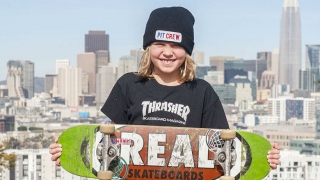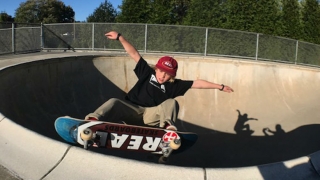Acute Lymphoblastic Leukemia: Nate’s Story
Published on
Published on
After Nate, now 7, was diagnosed with acute lymphoblastic leukemia (ALL), his parents, Scott and Danielle, were determined to keep their lives as normal as possible. That meant taking things in stride and trying to keep up their active lifestyle. Nate mirrored their can-do attitude. Once his most intense chemotherapy was finished, he immediately and enthusiastically took up a new hobby: skateboarding.
 Nate’s cancer diagnosis came just before he turned 4. “Looking back, for a few months prior to that we probably noticed things — nosebleeds, low-grade fevers at daycare, a lot of fatigue,” says Scott. But nothing seemed alarming. As Scott puts it, “You never remotely put this together with leukemia.” Then Scott and Danielle went away for a week and Scott’s mother watched Nate. “When we got back, she said to us, ‘Something’s wrong,’” Scott recalls. “She hadn’t seen him in a while and noticed a difference.”
Nate’s cancer diagnosis came just before he turned 4. “Looking back, for a few months prior to that we probably noticed things — nosebleeds, low-grade fevers at daycare, a lot of fatigue,” says Scott. But nothing seemed alarming. As Scott puts it, “You never remotely put this together with leukemia.” Then Scott and Danielle went away for a week and Scott’s mother watched Nate. “When we got back, she said to us, ‘Something’s wrong,’” Scott recalls. “She hadn’t seen him in a while and noticed a difference.”
They took him to his pediatrician, who ordered bloodwork. Danielle got the dreaded phone call, telling her to take Nate to Children's Hospital of Philadelphia’s Emergency Department immediately. “It was 4 or 5 in the afternoon on a Tuesday when my wife called and said ‘leukemia,’” says Scott. Nate was admitted and started on chemotherapy.
In the midst of all their fear and uncertainty, Scott and Danielle found one element they felt certain about: “That first night, one of the biggest things is that we both knew we were in the right place,” Scott says of CHOP.
“We loved our physicians at CHOP. That was one less decision to make and one less thing to be concerned about. We’re always grateful for that..”
From the start, Scott and Danielle resolved to do what they could to keep a level-headed attitude. “Our approach was always very measured,” says Scott. “We didn’t have control over what was happening. The only thing we have control over is how we go through it. This is a long journey. Let’s just not make a big deal out of everything. If you’re getting surgery, you’re getting surgery. We’re not going to freak him out.”
Impressively, Nate followed suit. “Obviously, it’s intense — he’s in the hospital, he’s hooked up to a pole, taking medicine,” says Scott. “But he took it fine. One thing about young kids, they haven’t learned to feel sorry for themselves.”
Nate’s oncologist, Sarah Tasian, MD, was struck by the family’s outlook. “I think the thing that has really distinguished them is their proactive attitude toward Nate’s therapy and very healthy dose of optimism,” she says.
A few months into Nate’s treatment, his parents realized something: Once the initial shock wears off, and you’re months into chemotherapy, it’s a lonely experience. Nate couldn’t be in enclosed spaces with other people because of his weakened immune system. He couldn’t play with other kids. Limiting his contact with the world meant he would later need to catch up.
 “When you come out of eight or nine months of chemo and you’re 4 1/2 years old, you’re behind everyone,” says Scott. But when Nate got some of his strength back, he sprung into action. “As soon as he got into the maintenance phase of therapy, he started skateboarding,” says Scott, who keenly supported his son’s new passion. “What more can you do for your kid than to teach him to fall and get up? And I just love the fact that he found something he loves to do.”
“When you come out of eight or nine months of chemo and you’re 4 1/2 years old, you’re behind everyone,” says Scott. But when Nate got some of his strength back, he sprung into action. “As soon as he got into the maintenance phase of therapy, he started skateboarding,” says Scott, who keenly supported his son’s new passion. “What more can you do for your kid than to teach him to fall and get up? And I just love the fact that he found something he loves to do.”
The family went hiking, climbing and bird watching, all with Dr. Tasian’s blessing. “My favorite phone call from Nate’s dad was asking if there was any reason why 6-year-old Nate couldn’t run a half marathon during maintenance therapy,” she says fondly. “My answer was the main reason not to let him run is that he’d embarrass me by running more quickly than I could!”
Nate’s passion for skateboarding came to the attention of a San Francisco company called REAL Skateboards. They created a skateboard with Nate’s name on it, which they’re selling with part of the proceeds going to CHOP’s Cancer Center.
“With their can-do, positive attitude, Nate and his parents are also incredibly altruistic about giving back to leukemia research at CHOP via fundraising, which is awesome,” says Dr. Tasian.
As for Nate now, “You’d have zero idea he’d ever been ill — you’d have less than zero,” says Scott, with pride. “He’s adapted to school now. He’s excelled. He’s amazing.”